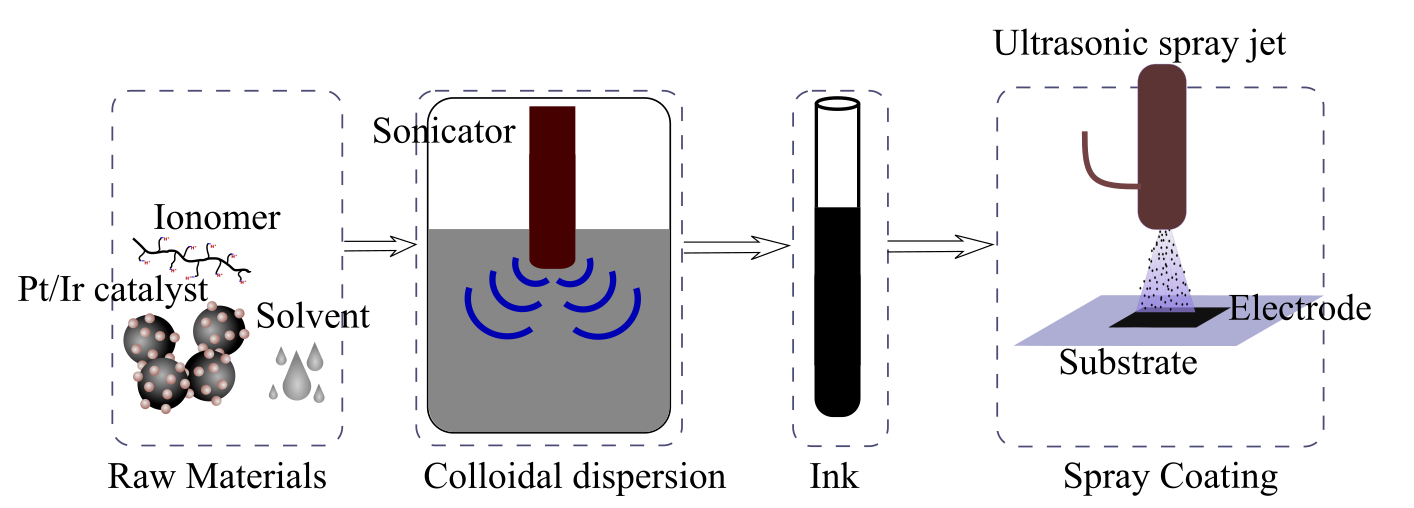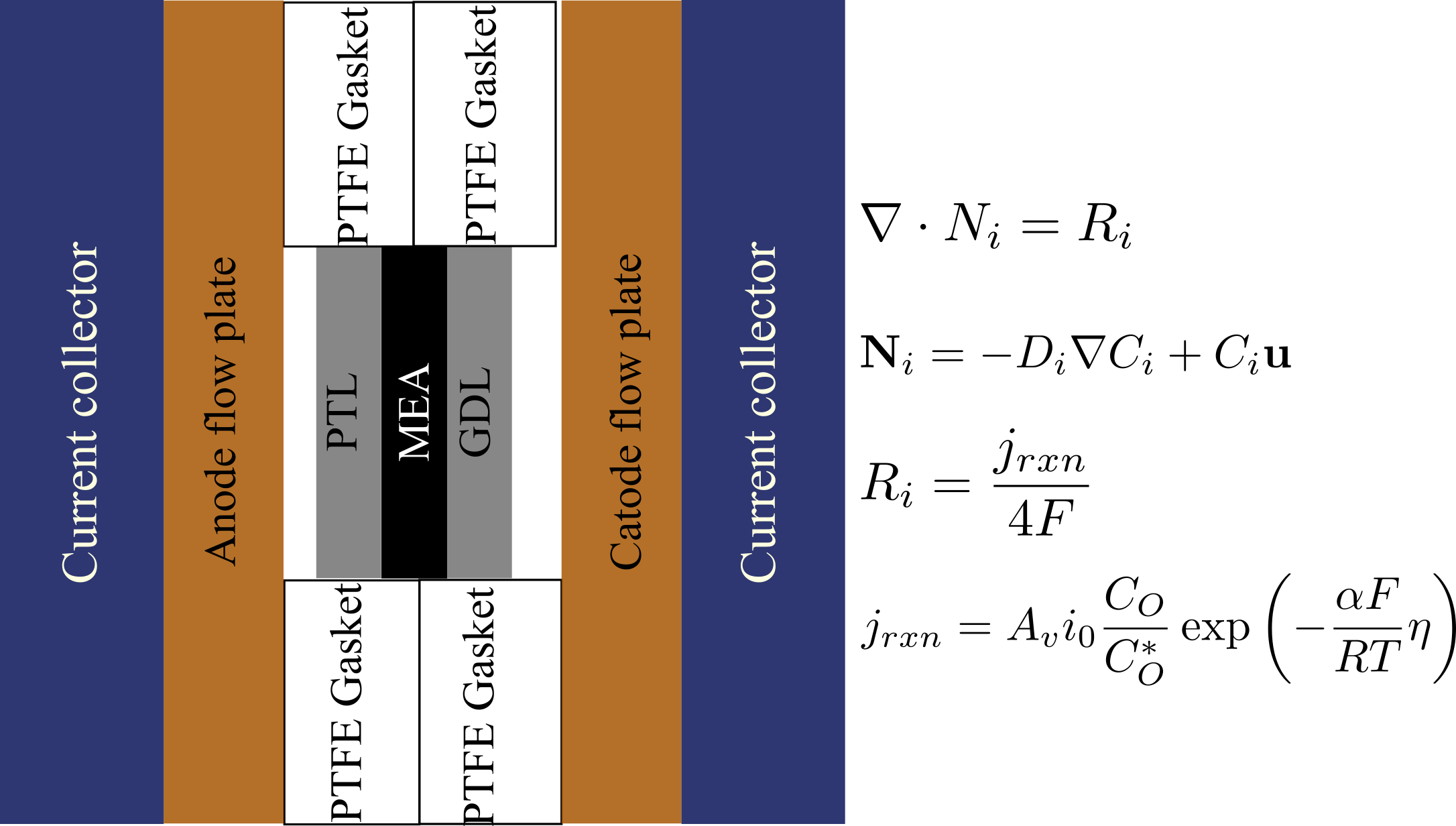Current Research
Fabrication and optimization of electrodes in fuel cells and electrolyzers
 Electrodes are the key components of any electrochemical system. Apart from changing the catalyst, the structure of the electrodes (catalyst layers) plays a key role in determining the performance of the system. Current research is focused on fabricating electrodes with low catalyst amounts using different methods. The fabricated electrodes are then structurally and electrochemically characterized. We use imaging (SEM, TEM, CT) for the physical characterization of electrodes and electrochemical methods (LSV, CV, pol-curve, EIS) for cell characterization. This enables us to understand the structure-property-performance relationships. Combined with numerical simulations, this work allows us to perform inverse design of electrodes for the desired cell performance.
Electrodes are the key components of any electrochemical system. Apart from changing the catalyst, the structure of the electrodes (catalyst layers) plays a key role in determining the performance of the system. Current research is focused on fabricating electrodes with low catalyst amounts using different methods. The fabricated electrodes are then structurally and electrochemically characterized. We use imaging (SEM, TEM, CT) for the physical characterization of electrodes and electrochemical methods (LSV, CV, pol-curve, EIS) for cell characterization. This enables us to understand the structure-property-performance relationships. Combined with numerical simulations, this work allows us to perform inverse design of electrodes for the desired cell performance.
Pore-scale characterization and analysis of electrodes
 The electrodes of fuel cells and electrolyzers are porous and layered in nature. A significant part of the performance is dependent on the transport properties of the porous media in both the solid and void phases. A detailed understanding of the pore structure is required to appreciate the pore-scale phenomena limiting the cell performance. This research is focused on getting the pore structure details of the electrode via imaging and then performing pore-scale physics simulations to understand different limiting factors. The pore-structure details are either obtained using imaging methods such as FIB-SEM and CT or are numerically reconstructed using stochastic reconstruction tools developed in-house (PMSRT). In-house physics simulation (openFCST) is then used to simulate pore-scale physics. The simulations are crucial to understanding the bottlenecks in the fabricated electrodes and also provide ways to mitigate the limiting factors.
The electrodes of fuel cells and electrolyzers are porous and layered in nature. A significant part of the performance is dependent on the transport properties of the porous media in both the solid and void phases. A detailed understanding of the pore structure is required to appreciate the pore-scale phenomena limiting the cell performance. This research is focused on getting the pore structure details of the electrode via imaging and then performing pore-scale physics simulations to understand different limiting factors. The pore-structure details are either obtained using imaging methods such as FIB-SEM and CT or are numerically reconstructed using stochastic reconstruction tools developed in-house (PMSRT). In-house physics simulation (openFCST) is then used to simulate pore-scale physics. The simulations are crucial to understanding the bottlenecks in the fabricated electrodes and also provide ways to mitigate the limiting factors.
Multi-physics simulation of electrochemical energy conversion systems
 Modeling provides an effective way to perform detailed analysis, diagnostics, and optimization. Our research is focused on numerical simulation of coupled physical phenomena in different electrochemical systems, such as PEM fuel cells, PEM electrolyzers, Ammonia electrolysis, and CO2 reduction. The models employ multiple transport phenomena (mass, momentum, ions, electrons, and heat) and kinetics (Butler-Volmer/Tafel/Heyrovsky) in a macro-scale continuum framework. We use commercial software like COMSOL as well as our in-house software (openFCST) for these simulations. The models can predict the steady-state and transient behavior of different electrochemical devices and are useful for performance and durability estimations, rapid diagnostics, and sensitivity analysis.
Modeling provides an effective way to perform detailed analysis, diagnostics, and optimization. Our research is focused on numerical simulation of coupled physical phenomena in different electrochemical systems, such as PEM fuel cells, PEM electrolyzers, Ammonia electrolysis, and CO2 reduction. The models employ multiple transport phenomena (mass, momentum, ions, electrons, and heat) and kinetics (Butler-Volmer/Tafel/Heyrovsky) in a macro-scale continuum framework. We use commercial software like COMSOL as well as our in-house software (openFCST) for these simulations. The models can predict the steady-state and transient behavior of different electrochemical devices and are useful for performance and durability estimations, rapid diagnostics, and sensitivity analysis.